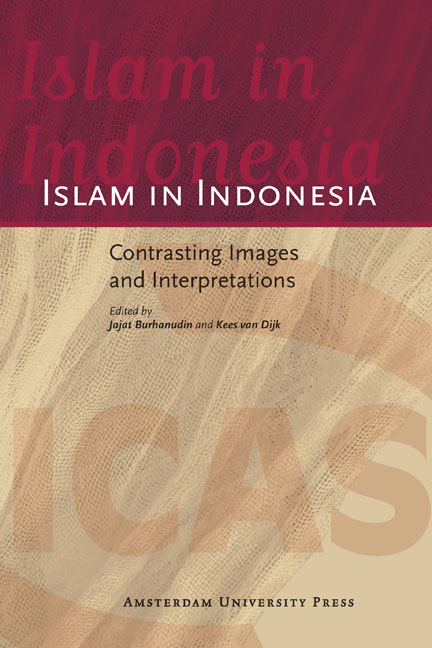Book contents
- Frontmatter
- Contents
- Introduction
- 1 Comparing Different streams of Islam: Wrestling with Words and Definitions
- 2 Defining Indonesian Islam: An Examination of the Construction of the National Islamic Identity of Traditionalist and Modernist Muslims
- 3 Indonesia in the Global Scheme of Islamic Things: Sustaining the Virtuous Circle of Education, Associations and Democracy
- 4 Distinguishing Indonesian Islam: Some Lessons to Learn
- 5 Islam, State and Society in Democratising Indonesia: A Historical Reflection
- 6 The Politics of Piety in the Pondok Pesantren Khusus Waria Al-Fattah Senin-Kamis Yogyakarta: Negotiating the Islamic Religious Embodiment
- 7 The Indonesian Muslim Feminist Reinterpretation of Inheritance
- 8 Managing Familial Issues: Unique Features of Legal Reform in Indonesia
- 9 A new Generation of Feminists within Traditional Islam: An Indonesian Exception
- 10 Religious Pluralism and Contested Religious Authority in Contemporary Indonesian Islam: A. Mustofa Bisri and Emha Ainun Nadjib
- 11 Islam and Humanitarian Affairs: The Middle Class and New Patterns of Social Activism
- 12 Dakwah radio in Surakarta: A Contest for Islamic Identity
- 13 Muslim Fundamentalism in Educational Institutions: A Case Study of Rohani Islam in High Schools in Cirebon
- 14 Majlis Tafsir Al-Qur’an and its Struggle for Islamic Reformism
- Glossary
- About the Editors and Contributors
- Bibliography
- Index
- Monographs
4 - Distinguishing Indonesian Islam: Some Lessons to Learn
Published online by Cambridge University Press: 09 January 2021
- Frontmatter
- Contents
- Introduction
- 1 Comparing Different streams of Islam: Wrestling with Words and Definitions
- 2 Defining Indonesian Islam: An Examination of the Construction of the National Islamic Identity of Traditionalist and Modernist Muslims
- 3 Indonesia in the Global Scheme of Islamic Things: Sustaining the Virtuous Circle of Education, Associations and Democracy
- 4 Distinguishing Indonesian Islam: Some Lessons to Learn
- 5 Islam, State and Society in Democratising Indonesia: A Historical Reflection
- 6 The Politics of Piety in the Pondok Pesantren Khusus Waria Al-Fattah Senin-Kamis Yogyakarta: Negotiating the Islamic Religious Embodiment
- 7 The Indonesian Muslim Feminist Reinterpretation of Inheritance
- 8 Managing Familial Issues: Unique Features of Legal Reform in Indonesia
- 9 A new Generation of Feminists within Traditional Islam: An Indonesian Exception
- 10 Religious Pluralism and Contested Religious Authority in Contemporary Indonesian Islam: A. Mustofa Bisri and Emha Ainun Nadjib
- 11 Islam and Humanitarian Affairs: The Middle Class and New Patterns of Social Activism
- 12 Dakwah radio in Surakarta: A Contest for Islamic Identity
- 13 Muslim Fundamentalism in Educational Institutions: A Case Study of Rohani Islam in High Schools in Cirebon
- 14 Majlis Tafsir Al-Qur’an and its Struggle for Islamic Reformism
- Glossary
- About the Editors and Contributors
- Bibliography
- Index
- Monographs
Summary
Indonesian Islam has a number of distinctive characteristics vis-à-vis Middle Eastern Islam, and perhaps ‘European Islam’ as well. By and large, Indonesian Islam is a moderate, accommodative kind of Islam and the least Arabicised form of the religion; a feature that it shares with certain segments of European Islam. Indonesian Islam is thus much less rigid than Middle Eastern Islam.
For this reason, Newsweek magazine once described Indonesian Islam as ‘Islam with a smiling face’; an Islam that in many ways is compatible with modernity, democracy and plurality. Despite these distinctions, Indonesian Islam is surely no less ‘Islamic’ than Islam elsewhere in the world. Geographically, Islamic Indonesia is located far away from the centres of Islam in the Middle East, but that does not mean that Indonesian Islam is religiously peripheral.
Islam has a great impact on various aspects of Indonesian life – religiously, socially, culturally and politically. This is not only due to the long history of Islam in the region, where the religion was accepted in earnest from the late twelfth century, but also because of the sheer demography of Indonesian Muslims, who represent more than 87 per cent of the country's total population. This chapter attempts to delineate some of Indonesian Islam's distinctive features, with the aim of offering some valuable lessons in terms of developing the aforementioned ‘European Islam’ or even a ‘Netherlands Islam’.
Lesson one: penetration pacifique
The formation of Indonesian Islam's distinctive characteristics has much to do with the peaceful spread of Islam, which T.W. Arnold calls a ‘penetration pacifique’ in his classic book, The Preaching of Islam (1913). The spread of Islam in the archipelago was not achieved through the use of force from Arabia or elsewhere, for instance, but rather by way of slow penetration over the centuries involving conflict that, in the end, resulted in the accommodation of local belief and cultures.
The process of the Islamisation of indigenous peoples in the archipelago, as A.D. Nock (1933) suggested, can be called ‘adhesion’ rather than ‘conversion’. If conversion – usually associated with revealed religions such as Judaism, Christianity and Islam – requires a complete break with old beliefs and full adoption of the new religion, adhesion is a slow and long process towards a greater conformity with the orthodoxy of the new religion.
- Type
- Chapter
- Information
- Islam in IndonesiaContrasting Images and Interpretations, pp. 63 - 74Publisher: Amsterdam University PressPrint publication year: 2013
- 2
- Cited by



